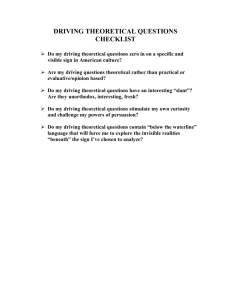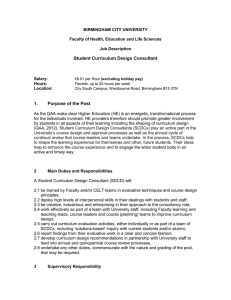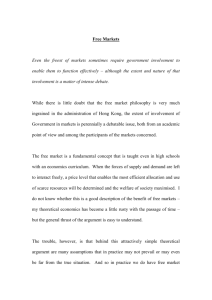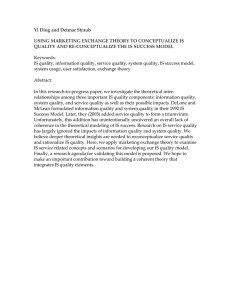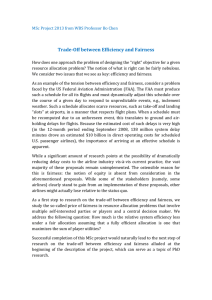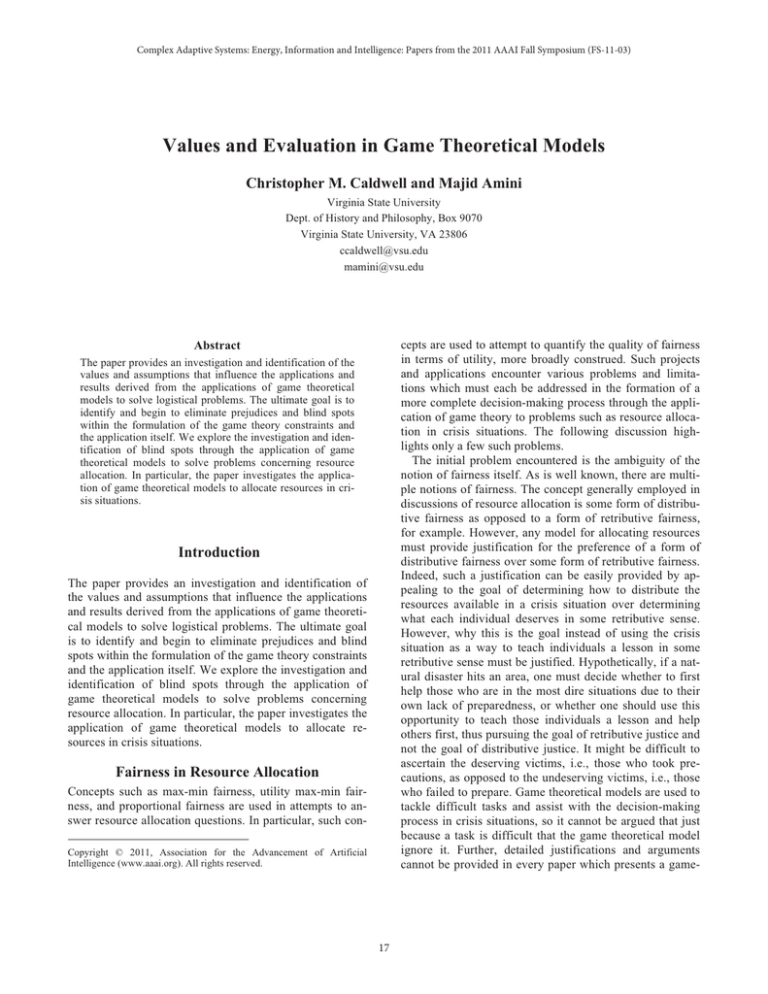
Complex Adaptive Systems: Energy, Information and Intelligence: Papers from the 2011 AAAI Fall Symposium (FS-11-03)
Values and Evaluation in Game Theoretical Models
Christopher M. Caldwell and Majid Amini
Virginia State University
Dept. of History and Philosophy, Box 9070
Virginia State University, VA 23806
ccaldwell@vsu.edu
mamini@vsu.edu
cepts are used to attempt to quantify the quality of fairness
in terms of utility, more broadly construed. Such projects
and applications encounter various problems and limitations which must each be addressed in the formation of a
more complete decision-making process through the application of game theory to problems such as resource allocation in crisis situations. The following discussion highlights only a few such problems.
The initial problem encountered is the ambiguity of the
notion of fairness itself. As is well known, there are multiple notions of fairness. The concept generally employed in
discussions of resource allocation is some form of distributive fairness as opposed to a form of retributive fairness,
for example. However, any model for allocating resources
must provide justification for the preference of a form of
distributive fairness over some form of retributive fairness.
Indeed, such a justification can be easily provided by appealing to the goal of determining how to distribute the
resources available in a crisis situation over determining
what each individual deserves in some retributive sense.
However, why this is the goal instead of using the crisis
situation as a way to teach individuals a lesson in some
retributive sense must be justified. Hypothetically, if a natural disaster hits an area, one must decide whether to first
help those who are in the most dire situations due to their
own lack of preparedness, or whether one should use this
opportunity to teach those individuals a lesson and help
others first, thus pursuing the goal of retributive justice and
not the goal of distributive justice. It might be difficult to
ascertain the deserving victims, i.e., those who took precautions, as opposed to the undeserving victims, i.e., those
who failed to prepare. Game theoretical models are used to
tackle difficult tasks and assist with the decision-making
process in crisis situations, so it cannot be argued that just
because a task is difficult that the game theoretical model
ignore it. Further, detailed justifications and arguments
cannot be provided in every paper which presents a game-
Abstract
The paper provides an investigation and identification of the
values and assumptions that influence the applications and
results derived from the applications of game theoretical
models to solve logistical problems. The ultimate goal is to
identify and begin to eliminate prejudices and blind spots
within the formulation of the game theory constraints and
the application itself. We explore the investigation and identification of blind spots through the application of game
theoretical models to solve problems concerning resource
allocation. In particular, the paper investigates the application of game theoretical models to allocate resources in crisis situations.
Introduction
The paper provides an investigation and identification of
the values and assumptions that influence the applications
and results derived from the applications of game theoretical models to solve logistical problems. The ultimate goal
is to identify and begin to eliminate prejudices and blind
spots within the formulation of the game theory constraints
and the application itself. We explore the investigation and
identification of blind spots through the application of
game theoretical models to solve problems concerning
resource allocation. In particular, the paper investigates the
application of game theoretical models to allocate resources in crisis situations.
Fairness in Resource Allocation
Concepts such as max-min fairness, utility max-min fairness, and proportional fairness are used in attempts to answer resource allocation questions. In particular, such conCopyright © 2011, Association for the Advancement of Artificial
Intelligence (www.aaai.org). All rights reserved.
17
theoretical model. However, the application of game theoretic models without the acknowledgment that such value
judgments are in fact playing a role in the application of
the model leaves the discussion of the game theoretical
model in question incomplete and lacking adequate conceptual foundations. An acknowledgement of the theoretical assumptions concerning the concepts being employed
at the level of the kind of fairness being pursued is necessary. Importantly, it appears that most applications of such
game theoretical models are done not only without the
recognition of such assumptions, but without realizing the
significance of the assumptions which have been made in
describing the problem to be addressed.
The next problem encountered is in the lack of clarification of the notion of utility itself that is the very foundation
for attempts to quantify the quality of fairness. The notion
of utility has many forms and can be measured in many
different ways. Classically, the notion of utility has been
connected to happiness simpliciter, or pleasure. However,
contemporary consequentialists have developed the notion
in more nuanced ways to attempt to deal with various problems. For example, the notion of utility has been defined in
terms of satisfying an individual’s preferences. Such a
move requires a further determination of whether all preferences are equal in such a calculation or whether some
preferences themselves should be preferred over others due
to other considerations, e.g. the rationality of the preferences under consideration. Additionally, as one attempts to
satisfy preferences, one must determine whether or not one
is going to attempt to satisfy the greatest number of preferences or whether there are some preferences that are worth
more than others. For example, should preferences concerning long-term well-being be privileged over preferences for short-term comfort in a crisis situation? This
question is exacerbated by the uncertainties surrounding
survival itself in certain crisis situations. The problem is
that these difficulties are generally ignored in applications
of game theoretical models in a way which we find to
make the applications incomplete in significant and serious
ways.
As an example of such problems, consider “Multievent
Crisis Management Using Noncooperative Multistep
Games” by Gupta and Ranganathan. The paper is motivated to address the meaningful, important, and significant
problem of allocating and scheduling response units in a
crisis situation concerning multiple events. In the paper,
they apply both utility max-min fairness and proportional
fairness very quickly. The paper argues that the application
of both of these concepts is often inadequately developed
and employed. However, Gupta and Ranganathan also employ evaluations outside of those of fairness. They explicitly make evaluative judgments concerning feasibility, criticality of the event, and optimal allocation without the necessary care or exposition in order to provide an adequate
justification for those evaluations. The ultimate problem is
apparent in the following paragraph, which occurs early in
the paper:
The uniqueness of the multiemergency scenario lies
in the fact that the modeling of the problem needs to
pivot around the objective of socially optimum and
“fair” allocation because, even if some event is of
low criticality, it has the potential to spawn more
crisis in case of delayed service. As an example, a
road accident with no major injuries is a low criticality event with a requirement of three or four police cars for traffic redirection. However, if the resources are not available on time, then the traffic
congestion may give rise to a disastrously critical
crisis situation like delay of service to other crises.
(578)
Multiple difficulties are immediately apparent. First, the
separation of social optimality and fairness reveal the assumption that the two concepts are somehow different.
However, a utilitarian conception of fairness would not
necessarily accept this split. A result that is socially optimal would be fair and a result that is fair would be socially
optimal for at least some utilitarians. Secondly, note the
evaluative judgments being made throughout the passage
without the acknowledgement of those judgments. The
following judgments are all evaluative in nature and impact
the analysis in important ways: that an event is a crisis, the
level of criticality of the crisis, the timeliness of the availability of resources, the significance of the injuries sustained, the level of traffic congestion requiring the additional police cars, and the disastrous situation of delay of
service mentioned at the end of the paragraph. The point
here is not that all such evaluative judgments must be fully
developed in every analysis, which is clearly impossible.
Instead the focus here is upon the effects of such evaluations upon analysis and game theoretical applications as
well as exploring the significance upon them within such
applications.
The Effects of Evaluative
Judgments and Concepts
Unacknowledged and unjustified evaluations, and the effects those evaluations have on game theoretical model
applications, illustrate a clear weakness of such applications. Although the attempt to quantify fairness is a common type of evaluation method, as mentioned previously,
other evaluations are clearly evident in these attempts to
determine how to allocate resources. Importantly, some of
these evaluations are used to change game theoretical
models in significant ways by removing constraints related
to moral evaluations if those morally significant evaluations turn out to cause inconvenient results. The goal in
this section is to discuss the effects of evaluative judgments and concepts within such concepts to identify some
of the key shortcomings of such applications. The goal,
18
ultimately, should be to better account for these difficulties
in future models to minimize these problems as much as
possible. However, overcoming the difficulties is not possible until the extent of the difficulties is recognized by
those applying the models. Thus, if a model results in a
distribution of resources that is determined to be fair but
not to be feasible, then the limits employed in the model
are changed to aid in gaining results that are feasible in the
relevant way, regardless of whether the results continue to
be fair.
To continue with the primary example, Gupta and
Ranganathan also employ evaluations outside of those of
fairness. They explicitly make evaluative judgments concerning feasibility, criticality of the event, and optimal allocation without the necessary care or exposition in order
to provide an adequate justification for those evaluations.
The consequences for the success of the model are significant.
Concerning feasibility, Gupta and Ranganathan state the
following, “In a multicrisis scenario the overall optimization is feasible only if each crisis has been satisfied with
respect to all other crises.” (579) In this passage there is an
attempt to explicitly identify what constitutes feasibility.
Although there is an attempt to define feasibility, the definition simply relies upon other evaluative judgments lacking the necessary and sufficient conditions for fulfillment.
In particular, the suggestion that feasibility relies upon the
satisfaction with respect to all other crises depends upon
the evaluative judgment of satisfaction and the ability to
determine this in relation to all other crises. If one is attempting to come to a quantifiable answer, such immense
and underdetermined qualitative judgments are clearly
problematic.
Even more significantly, consider the statement that any
allocation vector is fair if, for any other “feasible allocation…the aggregate of proportional changes is nonpositive
in terms of utility and is nonnegative in terms of the total
cost of allocation.” (587) The very notion of feasibility is
thus central to the judgments of fairness being made. The
evaluative claim of feasibility, which is problematic as
previously stated, is thus embedded in the notion of fairness in a manner which undermines the clarity and even
the determinacy of the notion of fairness being employed
in the application of the game theoretic model in this instance.
The judgment of the criticality of the event is of central
importance when determining how to allocate resources in
a crisis situation. Gupta and Ranganathan are right to
acknowledge this and attempt to say something about criticality itself. The problem is the lack of specificity and development in their notion of criticality. They state that
there is to be a criticality level “associated with each crisis
which decides the sequence in which the games are to be
played.” (583) The details of how this evaluation is to be
made are not clearly articulated. The judgment itself is
embedded in an algorithm, which highlights our concern.
Evaluative concepts are working at a level of importance
not recognized by those applying the theoretical models to
solve problems. The mathematics in the models may be
perfect, but this underlying problem undermines their ability to provide useful and applicable results. This is a problem to which we will return later in the paper.
The notion of the optimality of allocation is central to the
very issue of resource allocation in a crisis. What one
wants is a quantifiable answer from a method for determining optimality. The idea is that the model in question will
provide such an answer. The central question, then, concerns whether a qualitative evaluative judgment such as
optimality can even be quantified. However, for present
purposes, we will put that question aside and simply assume that such quantification is possible. Significant problems remain. The kind of optimization will clearly change
the results. For example, if one is using a max-min model
of measurement or if one is using a proportional method of
measurement, one will come to different conclusions concerning optimality. Thus, depending upon the judgment
concerning the optimal type of measurement to be used,
the results will clearly be affected. Even if one uses different types to run the model in different ways, then the underlying judgment remains to be made at the moment of
implementation if the results of the models run. If the goal
is to actually use these models to guide the responses in
crisis situations, which we take it to be, then the particular
evaluative judgment concerning optimality itself is playing
a central role and needs to be much more carefully examined and explored.
Ultimately, in some cases, the definition of morally significant evaluations, such as fairness, are altered in order to
meet constraints such as feasibility, but the revised definition is problematic given that the evaluative nature of the
constraints themselves are overlooked. The goal is to come
to a course of action that is fair, in some sense, but when
the model comes to a result which seems fair in the relevant sense then some other consideration overrides the
result. The problem occurs when the evaluative nature of
the overriding consideration is either overlooked, ignored,
or buried in some fashion. The difficulty is that their attempt at quantification is undermined due to the incomplete recognition of the evaluative judgments which are
being made throughout the process.
The point here is not that these problems cannot be overcome nor that such models are not of significant use and
importance. The point is simply that there are some unstated assumptions which are more complicated and need to be
more significantly addressed if the move to quantify the
seemingly qualitative judgments necessary in coming to
result in how to allocate resources in crisis situations is to
be successful.
19
shows, backward induction is fraught with difficulties.
Basically, the problem here is that the model ignores the
real possibility of an agent deciding not to follow the rules
of the game and at the same time not incur any accusation
of irrationality as axiomatically assumed by the theory. In
other words, the theory imposes a very rigid sense of rationality and fails to allow counterfactual reasoning on the
part of one or more players in the game. As Varoufakis
notes, thinking “about the possibility of defying the theory
that is supposed to govern one’s behaviour, is a uniquely
human capacity. It is also a capacity that makes the life of
the social scientist inordinately demanding. To disallow
counterfactuals within a theory … is to ask for serious
trouble since human rationality has the bad habit of instructing agents to ask, ‘what if I do not obey the theory’s
rules?’” (400)
Generally, it seems as if counterfactual reasoning is both
rational and irreconcilable with equilibrium game theory.
By relaxing the stringent conception of rationality as imposed by game theory, one can easily see that some of the
game’s players may rationally come to different conjectures which may after all turn out to be the actual choice of
strategies, obviously not predicted by the other party.
(Bernheim, 1984) Players may engage in attempts such as
outmaneuvering and embark upon thoughts that will effectively engender the impossibility of securing symmetry and
instead lead in the long run towards what Skyrms (1990)
calls deliberational disequilibrium.
The fundamental problem here may be traced back to
an endemic confusion over the concept of equilibrium. On
the one hand, one may identify an ontological reading of
equilibrium whereby the term is intended to denote an aspect of the actual reality that the theorist is attempting to
understand, describe, explain, or represent, whereas a second theoretical rendering of it attempts to portray a property of a mathematical-deductive model formulated apparently with the intention of explaining, representing, or
somehow increasing our understanding of social reality.
But as Lawson points out “not only are these two conceptions distinct … but also, in practice, they have little bearing on each other.” (455) For, the theoretical notion does
not bear a one-to-one correspondence to the agents of the
ontological conception where each player holds his or her
own beliefs, desires, attitudes and other intentional states –
states that through being intentional manage to introduce
non-uniqueness into the framework. As in the case of
econometrics, Hoover notes, “Economic values and motivations may be powerful, but other – higher – values and
motivations may dominate in particular cases and mask the
economic tendencies.” (48) Moreover, the problems are
further compounded when theoretical models of equilibrium are constructed by incorporating concepts and notions
like optimization that do not seem to have an equivalent
counterpart in the ontological variety. (Chick, 1998) Thus,
until and unless, econometric or game theoretic models
manage to capture the non-uniqueness element of human
Theory Application Problems
More Generally Considered
Hitherto, game theoretical models have been assayed and
assessed from an ethical perspective with the primary purpose of appropriately pruning the models to overcome pitfalls and shortcomings hindering their applicability. Yet,
there are some game theory practitioners, let alone detractors, that go even further in their ethical criticism of models by arguing that the “confusion between ‘is’ and ‘ought’
in game theory is widespread and is a serious obstacle to
developing the theory along more productive lines” to the
point that it is astounding that so many years of elegant
mathematical “theorizing and experimentation could produce so little of value in instructing people on how they
should behave in conflict situations and in predicting how
they do behave in conflict situations.” (Kadane & Larkey,
1370)
However, in addition to ethical concerns, there are also
epistemological problems that seem to have contributed to
the difficulties faced by game theoretical models in reallife contexts. In this respect, there seems to be an uncanny
correspondence between game theory and its mathematically inspired elder sibling, viz. econometrics, where similar complaints and criticisms have been raised. Despite the
presence of sophisticated and intricate formalizations, as
Milton Friedman once complained, the extensive application of mathematics in econometrics “is often used to impress rather than inform.” (36) On the incongruence between modeling and application, Coddington, amongst
others, points to the difficulty of investing the formal
framework with an application by noting that the framework is syntactical and fails to offer any rules for transmitting the internal precision of the syntax to the semantic
problem of application. (550-3) Thus, the rest of this brief
section is concerned with some of these epistemological
issues that game theory modeling has to contend with in
the pursuit of practical applicability.
There are a number of standard epistemological problems raised against game theoretical models such as: (i)
they are too hard to use, (ii) they form an incoherent collage suggesting no general principles, (iii) they are hard to
test, and (iv) they can explain anything. (Camerer, 1991)
However, the focus here is narrowed onto the notion of
rationality vis-à-vis equilibrium.
Equilibrium game theory has borrowed its rationality
precept from neoclassical economics, and by deploying the
method of backward induction and subgame perfection it
has attempted to construct models of social interaction for
various contexts. According to the theory, in any such social game there is a unique outcome provided that each
player is entirely rational, and then the behavior of each
agent is tracked through backward induction whereby the
model attempts to generate a unique equilibrium set of
beliefs that allows each player to arrive at a conclusion
about the best course of action. But, as Sugden (1991)
20
decision-making and refrain from belaboring human behavior with conditions such as of optimization, the models
are no more than self-referential constructs, even though
mathematically very elegant and sophisticated.
Acknowledgment
The authors would like to thank the Office of the Provost
at Virginia State University and the Provost/Vice President
for Academic Affairs Dr. W. Weldon Hill for the funding
which supported this research.
References
Bernheim, D. 1984. Rationalisable Strategic Behaviour. Econometrica. 52: 1007-28.
Camerer, C.F. 1991. Does Strategy Research Need Game Theory? Strategic Management Journal. 12: 137-152.
Chick, V. 1998. On Knowing One’s Place: The Role of Formalism in Economics. The Economic Journal. 108 (451): 1859-1869.
Coddington, A. 1975. The Rationale of General Equilibrium Theory. Economic Inquiry. 13: 539-58.
Gupta, U., and Ranganathan, N. 2007a. Multievent Crisis Management Using Noncooperative Multistep Games. IEEE Transactions on Computers. 56 (5): 577-589. 1991.
Friedman, M. Old Wine in New Bottles. The Economic Journal.
101 (404): 33-40.
Hoover, K.D. 2002. Sutton’s Critique of Econometrics. Economics and Philosophy. 18: 45-54.
Kadane, J.B., and Larkey, P.D. 1983. The Confusion of Is and
Ought in Game Theoretic Contexts. Management Science. 29
(12): 1365-1379.
Lawson, T. 2005. Reorienting History (of Economics). Journal of
Post Keynesian Economics. 77 (3): 455-470.
Skyrms, B. 1990. The Dynamics of Rational Deliberation. Cambridge, MA: Harvard University Press.
Sugden. R. 1991. Rational Choice: A Survey of Contributions
from Economics and Philosophy. The Economic Journal. 101:
751-85.
Varoufakis, Y. 1993. Modern and Postmodern Challenges to
Game theory. Erkenntnis. 38 (3): 371-404.
21

